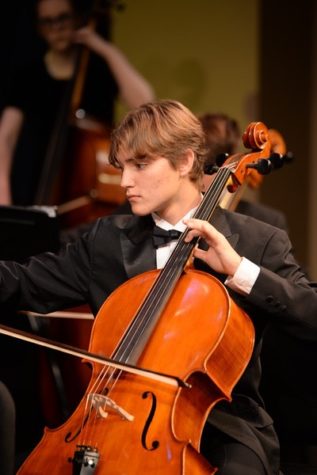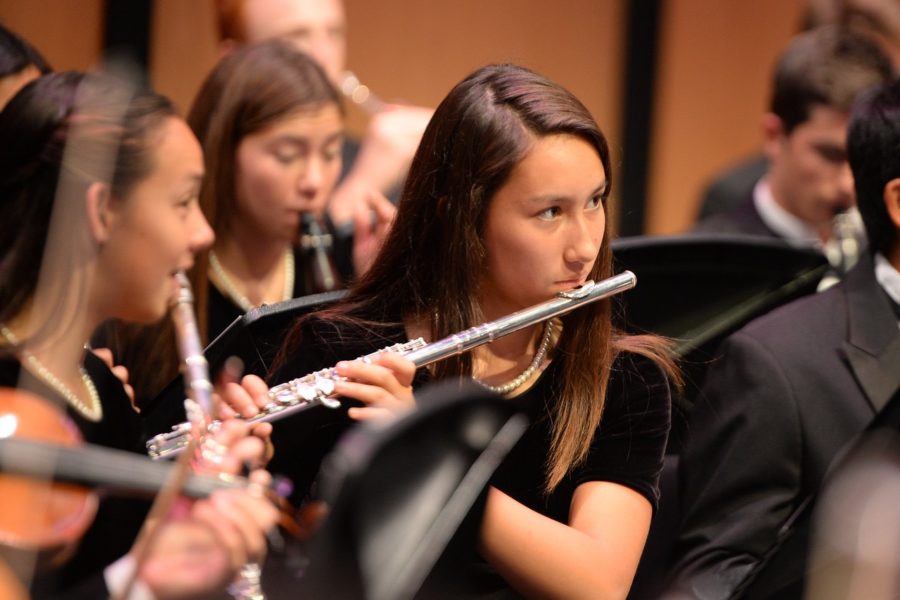At the front of the room, the conductor lifts his baton. The musicians watch closely, waiting for the signal. He quietly counts the beats: one, two, three, four, then the room explodes with sound.
The cymbals crash and the brass begins the melody. The conductor continues to count the beats as his left-hand gestures to the orchestra to play louder. The string players concentrate on the sheet music, focusing on the notes dancing across the page as the phrase reaches its climax. The music reverberates through the room. The conductor puts down his baton and begins to work with each section to improve their parts.
This is Carlmont’s music program, where students hone their musical skills. The instrumental program is split up into four primary ensembles: Concert Band, String Orchestra, Symphonic Band, and Symphony Orchestra. In addition to these larger groups, there is also a smaller Jazz Ensemble, composed of musicians solely focused on the jazz section of the repertoire.
“String Orchestra and Concert Band are comprised of students who are less serious about music because there is no audition requirement,” Lilly He, a violinist in Symphonic Orchestra, said. “Symphonic Orchestra attracts people who like classical music because the instruments in this group allow it to play classical music that the other groups cannot. The few students in Jazz Ensemble are highly dedicated to music, spending lunchtime as a continuation of the class.”
In each class, students are further split by section. The string section includes violins, cellos, and violas; the woodwind section is comprised of flutes, oboes, and clarinets. The brass section is composed of trumpets, tubas, and French horns; and the final section, percussion, includes different types of drums, xylophones, and other instruments that can be struck or rattled.
Under the guidance of music director John DaBaldo and assistant music director Brian Switzer, the sections learn how to work together as a group to produce quality music.
“When we first get in, we spend five to 10 minutes warming up. Then the teachers come in and we play over pieces. They’ll stop us when we need to work on some specific part. Now and then, we’ll have sectionals, where different sections will go into a practice room with a private teacher, and they’ll get help,” Vyas Kepler, a trumpeter in Symphonic Band, said.
In addition to daily music classes, the program puts on several concerts throughout the year, the largest of which are the Winter and Spring concerts. Carlmont has been working hard to perfect its musical curriculum for many years to put on these big productions. The program has been in existence since the 1950s, attracting many different musicians over the years.
“At Carlmont, we have many high-level musicians who are very passionate about what they do. I love feeling the music, especially when I connect with a certain piece,” Jonathan Su, a viola player in Symphonic Orchestra, said.
Carlmont has a close group of musicians, who not only enjoy playing together but also have fun within the musical setting.
“The Carlmont music program is very united. Each section strengthens their bonds through inside jokes and time spent together. I enjoyed Orchestra, not only because of the music but because of the people who sat near me,” Shiina Sugioka, a former violinist in the program, said.
However, it’s not all fun and games. Playing at such a high level means that these musicians must understand the nuances of the pieces.
“I think it’s frustrating when we know we can play better but it isn’t working. There are a lot of passionate musicians who have different ideas of how the music should be played, which makes balancing each perspective complicated,” Su said.

Wesley Costa plays the cello.
Despite all these setbacks, the students are still excited to be a part of the program. The opportunities that the program brings to musicians transcends frustrations.
“The music program allows people to freely express themselves. People can try something new or do something they already enjoy. In the program, you can go places and meet other people that share a similar interest. You perform for people at school and outside of school. It’s a great opportunity to meet new people,” Sydney Phan, an oboist in Concert Band, said.
Students also get a chance to meet people outside of the local community. Every year, musicians in the program get a chance to travel to competitions to test their newly-honed skills.
“This year, Symphonic Band and the Jazz Ensemble are taking a tour to Chicago. We’re going to watch the Chicago Symphony and take a look around the city. We’re also going to be performing and attending clinics at DePaul University. Then, we’ll also see a couple of Chicago high schools. Their directors will work with our musicians, and we’ll work with their groups,” Switzer said.
Carlmont also offers a chance for students to learn how to take their playing to the next level and continue their music career after high school.
“A jazz combo is coming in from New York, all composed of Juilliard and the Manhattan School of Music graduates. They are going to do a concert and Q&A about how to get into an elite music school and then a workshop with the Jazz Ensemble. Our program is striving to provide excellent experiences like that,” Switzer said.
However, students believe one of the most impactful experiences the music program provides is the sense of community that helps connect students to their peers and the school.
“Music continues to be one of the greatest inspirations for young people. Whether it be classical music or modern music, music gives an identity to an individual. The music we enjoy and associate with contributes greatly to personality and affiliation,” Sugioka said. “I think it’s important for Carlmont to provide a place for students to freely express themselves through music. Students feel like they belong in instrumental music or choral music; it’s a sense of home and identity.”












